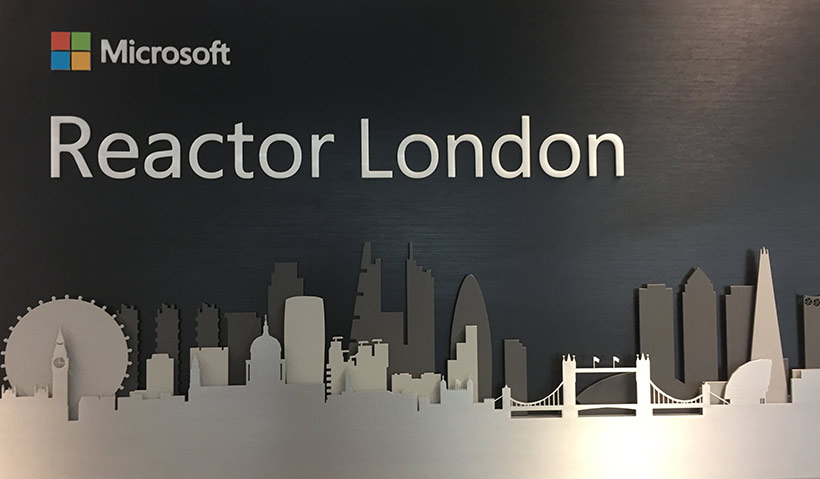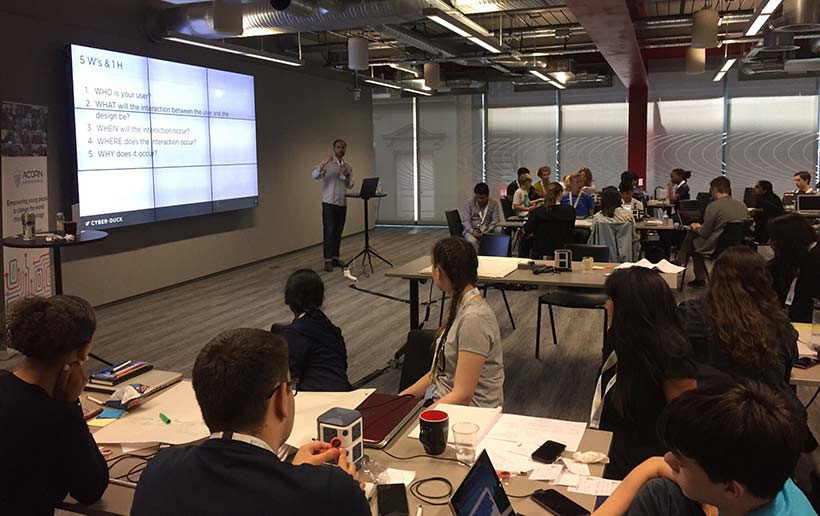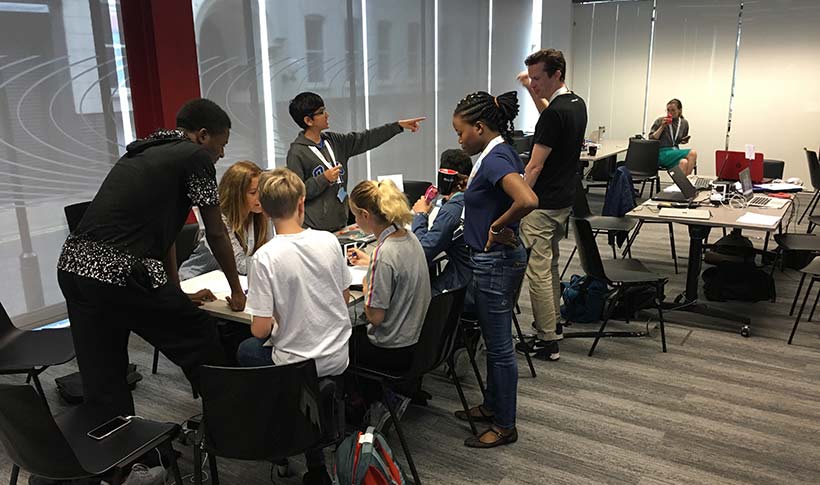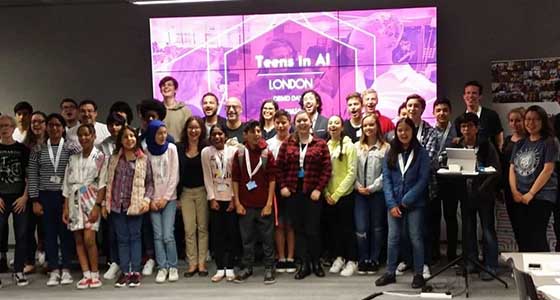At Teens in AI, Ollie Moser and I tutored a group of talented teens in the art of Design Thinking. Here, I'll talk you through my time over the weekend at the hackathon. (Spoiler alert: I was very impressed!)
The end of May saw the most recent Acorn Aspirations Bootcamp & Hackathon for Teens: this time it was about all things Artificial Intelligence (AI). Teens in AI was launched at the UN's AI for Good Global Summit in Geneva, championed by all-round superstar, Elena Sinel. It's a truly inspiring initiative, founded on the principle of educating the next generation of AI specialist designers, coders, and creators.
The 45 AI enthusiasts who attended, aged between 12 and 17, had already attended a week long bootcamp learning about coding, algorithms, and AI. The bootcamp culminated in a 2-day hackathon where they would research, ideate, design, code, and present their projects, where the challenge was to use AI and machine learning for good.
The hack was held at Microsoft Reactor in London, and all the teams were supported by a group of amazing expert mentors covering Tech, Business, Design, and User Experience. The mentors hailed from respected institutions such as Microsoft, Udacity, UCL, London Business School, CogX, and Cyber-Duck.

Teens in AI was hosted by Microsoft Reactor London. Ollie was too shy to pose with the sign, but isn't it fantastic?
Day 1
Myself and fellow Cyber-Duck UXer, Ollie Moser, had the pleasure of being asked by event organiser (and all round superhero), Elena Sinel, the founder of Acorn Aspirations, to run a three-hour workshop on Design Thinking.
This intensive crash course would help the young Hackers get started on formulating their project ideas and designs. They wanted to jump straight into coding, but Elena knew we had to make sure they started by thinking about who their users were, what their users’ real needs were, and how they would validate what they found out.
The Challenges
To set the challenges there were four great talks on subjects aimed at reflecting the UN Sustainable Development Goals (SGDs) and to try and see what AI-driven solutions the Hackers would come up with for these impactful issues.
The Topics & Challenges:
- Mental Health – How might we use AI to make online spaces safer for girls and women? by Aimee Bryan (Founder, Project Kitchen Table)
- Climate Change – How might we use AI to inspire and enable more people to be changemakers in their day-to-day lives? by Richard Milburn (Co-Founder, Tunza Games)
- Equality – How might we use AI to help teens find their voice and be heard? by Josephine Young (AI Ethicist and Feminist)
- Embodying Confidence – Create an experience using AI and VR to help girls gain more confidence? by Kim Arazi (Founder, IN3)
What They Learned
I won’t lie, we were a bit concerned about whether the youngsters might lose interest or not understand Design Thinking, but any worries we had went out of the window straight away! To be honest, their focus and uptake speed was incredibly impressive; I’ve had roomfuls of business executives with shorter attention spans and a slower grasp of the basics of Design Thinking.

Ollie discusses Design Thinking with the young hackers at Teens in AI.
We knew we had a lot to get through, but we didn’t go easy on the young Hackers. By getting them to focus on the double diamond, and getting them to do a variety of exercises, in just a couple of hours they had:
- Written their problem statements
- Got to grips with validating their initial assumptions by repeatedly asking the 9W’s and 1H (Who, What, When, Where, Why x5, and How?)
- Aligned the direction of their team
- Conducted interviews and sent out surveys
- Understood how to ask the right questions
- Carried out online research
- Documented their findings
- Created Personas
I’ll say it again: I still can’t believe how good these youngsters were at applying what they had just learnt to their projects and design process. We concluded the session with a quick look at what AI does now and what it might do in the future, then gave them some UX tips on designing for AI.
Day 2
So, we went home and left the Hackers working hard on their projects. When we returned the following day, the walls were covered in post-its, Kanban boards, wireframe sketches, Chatbot scripts, business plans, and persona information. It was amazing!

When I arrived the following day, the teens had been super productive. This is just a glimpse of the research they produced.
With research completed, coding and prototypes finished, tensions were on the rise and the first signs of burnout started to show – they had been going for a week after all! Nevertheless, the Hackers made it to the final part of the Hackathon: the presentations! Across the six teams there was an even split between Global Warming Projects and Mental Health / Equality & Confidence Projects.

Our talk over, Ollie and I stuck around to help the teams design their amazing products.
The Presentations
All of the teams had to present their projects after an intense hackathon session. We were very impressed!
Mental Health Hacks
The projects looking to improve mental health amongst teens by helping them find their voice were:
Team ‘Power Me Up’: An interactive VR game, initially aimed at teenage girls, that puts users in social situations and provides advice on body language so users can learn and practice how to embody confidence.
Highlight: A working VR demo.
Team ‘Hablar’: Created a voice-only forum and safe space, where teens could record their voice, allowing them to air their inner-concerns. Voice filters would boost their confidence as anonymity would protect their privacy. AI would connect them with like-minded people, as well as mass-moderating the comments posted to prevent any trolls.
Highlight: A working demo of voice record and filters coded from scratch.
Team ‘Feelix’: A teenage-friendly app aiming to remove the stigma surrounding mental health, allowing teenagers to speak about their issues to a personalised chatbot, powered by AI.
Highlight: Great research, and a prototype with a working chatbot.
Team ‘Furiend’: A fast-learning chatbot for teens to reduce stress in their day-to-day lives. A safe place they can discuss what is stressing them out (school, family etc.) AI powered by IBM’s Watson.
Highlight: Research, beautiful design, and a very smart chatbot.

During the presentations, we saw all of. the quality work the teams had accomplished.
Global Warming Hacks
The projects looking to tackle Global Warming were:
Team ‘CliMate’: An app that would tap into teens social activities and combine it with environmental meetups and events, where they can make friends, and earn points that they can then spend at stores.
Highlight: Well thought-out user journeys on both sides of the app. A working prototype.
Team ‘Bryte’: Smart traffic lights that coordinate traffic light sequences and reduce fuel consumption/waste. AI would watch traffic and adapt traffic lights to improve efficiency.
Highlight: Great research and presentation. Dealt with difficult questions from the judges like it was easy.
Team ‘Footprint’: An app that will help reduce our carbon footprint, by using AI to learn your travel patterns, and to recommend alternative routes that use less CO2. Points could be earned and spent on environmentally friendly activities and products.
Highlight: A very well thought-out product, with sophisticated AI coded from scratch.

We were blown away by the fully functioning AI prototypes during the presentations!
And the Winners Are...
The judges were very impressed by all the projects. “We can’t believe you have done all this over two days!” said one judge. “You have all been much better at presenting your ideas than most startups I have seen pitch,” said another blown-away judge.
I didn’t envy them having to pick the winners as all the projects were so good.
Prize 1: Free nano-degrees for all team members from Udacity.
The winners: Team Feelix
Prize 2: Two teams will get the chance to present their project at the CogX AI conference in London.
The winners: Team Footprint and Team Hablar

The runners-up prize of Teens in AI was the chance for two teams to present their projects at CogX. It was just as inspirational at the conference as at it was at the hackathon.
What We Learned
If there's just one thing we learned, it's that these guys are all amazing!
The next generation of coders and product designers are not only bridging the divide between those two skills (they are coding AND using design thinking!), but they’re also very conscious of designing products that impact people’s lives and don’t “just make money” by “making you addicted to your screen”.
As Elena, the organiser, rightly argues:
“Design thinking should be taught at schools… Imagine what would happen if all kids had this approach? It’s not just about design, but life in general!”
The future is bright - I just hope I can keep up!


